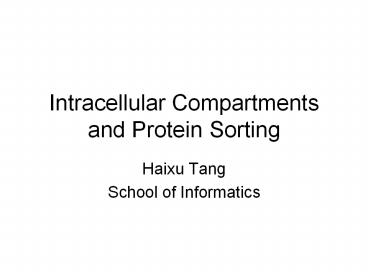Intracellular Compartments and Protein Sorting - PowerPoint PPT Presentation
Title:
Intracellular Compartments and Protein Sorting
Description:
The major intracellular compartments of an animal cell ... INTRACELLULAR COMPARTMENT. An electron micrograph. Development of plastids ... – PowerPoint PPT presentation
Number of Views:520
Avg rating:3.0/5.0
Title: Intracellular Compartments and Protein Sorting
1
Intracellular Compartments and Protein Sorting
- Haixu Tang
- School of Informatics
2
The major intracellular compartments of an animal
cell
3
Relative Volumes Occupied by the Major
Intracellular Compartments
INTRACELLULAR COMPARTMENT INTRACELLULAR COMPARTMENT PERCENTAGE OF TOTAL CELL VOLUME
Cytosol 54 54
Mitochondria 22 22
Rough ER cisternae 9 9
Smooth ER cisternae plus Golgi cisternae 6 6
Nucleus 6 6
Peroxisomes 1 1
Lysosomes 1 1
Endosomes 1 1
4
An electron micrograph
5
Development of plastids
6
Hypothetical schemes for the evolutionary origins
of some organelles
7
Four distinct families
- the nucleus and the cytosol, which communicate
through nuclear pore complexes and are thus
topologically continuous (although functionally
distinct) - all organelles that function in the secretory and
endocytic pathways, including the ER, Golgi
apparatus, endosomes, lysosomes, the numerous
classes of transport intermediates such as
transport vesicles, and possibly peroxisomes - the mitochondria
- the plastids (in plants only).
8
Secretory vs. endocytic pathways
9
Protein traffic
10
Protein traffic
- Gated transport
- Transmembrane transport
- Vesicular transport
- membrane-enclosed transport intermediates
11
Sorting sequences
12
Some sorting sequences
13
Prediction of protein sorting
- Psort web server http//psort.nibb.ac.jp/
- prediction of protein localization sites in cells
from their primary amino acid sequence
14
(No Transcript)
15
(No Transcript)
16
Construction of Membrane-enclosed Organelles
Require Information in the Organelle Itself
- The information required to construct a
membrane-enclosed organelle does not reside
exclusively in the DNA that specifies the
organelle's proteins. Epigenetic information in
the form of at least one distinct protein that
preexists in the organelle membrane is also
required, and this information is passed from
parent cell to progeny cell in the form of the
organelle itself. Presumably, such information is
essential for the propagation of the cell's
compartmental organization, just as the
information in DNA is essential for the
propagation of the cell's nucleotide and amino
acid sequences.
17
Nuclear pore complexes
18
Nuclear Envelope
19
Nuclear lamina
- Consists of "intermediate filaments", 30-100 nm
thick. - These intermediate filaments are polymers of
lamin, ranging from 60-75 kD. - A-type lamins are inside, next to nucleoplasm
B-type lamins are near the nuclear membrane
(inner). They may bind to integral proteins
inside that membrane. - The lamins may be involved in the functional
organization of the nucleus.
20
Nuclear localization signals (NLSs)
21
Protein import through nuclear pores
22
Possible paths for free diffusion through the
nuclear pore complex
23
Nuclear Import / Export Receptors
24
The control of nuclear import during T-cell
activation
25
The breakdown and re-formation of the nuclear
envelope during mitosis
26
The subcompartments of mitochondria and
chloroplasts
27
A signal sequence for mitochondrial protein
import
28
Protein translocators in the mitochondrial membra
29
Protein translocation depends on the temperature
30
Protein import by mitochondria
31
Energy required
32
Two plausible models of how mitochondrial hsp70
could drive protein import
33
Protein import from the cytosol into the inner
mitochondrial membrane or intermembrane space
34
Translocation of a precursor protein into the
thylakoid space of chloroplasts
35
The Endoplasmic Reticulum
36
Free and membrane-bound ribosomes
37
The signal hypothesis
38
The signal-recognition particle (SRP)
39
SRP direct ribosomes to the ER membrane
40
Protein translocation
41
Single-pass transmembrane protein
42
Multipass membrane protein rhodopsin
43
Protein glycosylation in the rough ER
44
The export and degradation of misfolded ER
proteins
45
The unfolded protein response in yeast
46
Phospholipid exchange proteins

